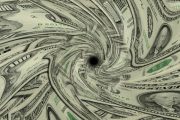
Who is William White? The name is bound to be less familiar than that of former Federal Reserve Chairman Alan Greenspan, but they are in similar lines of work. In answer: White was one of the few economists who grew uneasy with the “irrational exuberance” of the 1990s.
But while Greenspan seemed to have forgotten why he’d uttered this phrase, White didn’t. White started talking and writing about what he had come to believe were some dangerous errors central bankers were making. No one would listen back then. He is being listened to now.
Born in Kenora, Ontario, in 1943, White studied economics at the University of Windsor and the University of Manchester. In 1969, he went to work for the Bank of England. In 1972, he returned to Canada and spent 22 years with the Bank of Canada’s Department of Banking and Financial Analysis. He rose rapidly in the ranks, becoming deputy chief of the Research Department in 1978, chief of the department in 1979, adviser to the governor in 1984, and finally deputy governor in 1988.
White joined the Bank for International Settlements (BIS) in June of 1994. Headquartered in Basil, Switzerland, the BIS is the central bankers’ central bank — arguably one of the most influential institutions in Western civilization. White’s title was manager in the Monetary and Economic Department. In May 1995, he became economic adviser and head of that department, and then chief economist, a position he retained until retiring in June 2008.
William White has therefore seen the centers of financial power from the inside. He has also had access to their data, the quantity of which is tremendous and spans the globe. What he saw was a disaster in the making, in the form of loose monetary policy that encourages the formation of bubbles. He began trying to warn others.
His arch-rival was none other than Alan Greenspan, who was serving on the BIS Board of Directors in addition to his role as Fed chairman. This made him White’s superior. Their rivalry dates to the mid-1990s. Having grown critical of Greenspan’s ideas on the role of monetary policy in 1996, White challenged Greenspan’s view that central bankers cannot slow the causes of asset bubbles. In an important meeting of the Kansas City Fed at Jackson Hole, Wyoming, White confronted Greenspan directly. White recommended “rais[ing] interest rates when credit expands too fast and forc[ing] banks to build up cash cushions in fat times to use in lean years.” Greenspan came away from that meeting unconvinced, believing that one can only clean up after the fact, as it were, when a bubble deflates. He said dismissively, “There has never been an instance, of which I’m aware, that leaning against the wind was successfully done.”
In plain English, what White was in essence challenging was the money creation that powered the tech bubble of the late 1990s, which was then fueling what Greenspan had termed “irrational exuberance.” In the 2000 decade, White observed the real estate bubble begin to develop. He noted the risky loans and the lack of credibility in the rating agencies. He and his immediate associates contended that the problem was the amount of cheap money floating around — encouraging what economists of the Austrian school call malinvestments.
Despite Greenspan’s unwillingness to listen, White forged ahead. He began penning and circulating reports within the BIS. He charted the practices that were leading to an accumulation of dollars (debt) and creating a long-term threat to the global economy. In 2006, he warned, “One hopes that it will not require a disorderly unwinding of current excesses to prove convincingly that we have indeed been on a dangerous path.” Central bankers speak a subtle language all their own. White was stating that he hoped his colleagues would change course before the U.S. financial system went down in flames and took much of the global economy down with it.
At the time, the possibility of the U.S. economy going down in flames seemed remote. While there had been a bump in the road earlier in the decade with the collapse of the tech bubble, the U.S. economy was again roaring ahead. The Dow was soaring toward new heights, and would top out at 14,164 on Oct. 9, 2007.
Greenspan, moreover, was “The Maestro,” the central banker whose monetary policy had made this surge possible. At the moment, he was untouchable. No one wanted to hear “doom and gloom.”
White recalled, “When you are inside the bubble, everybody feels fine. Nobody wants to believe that it can burst. Nobody is asking the right questions.”
When Ben Bernanke replaced Greenspan as Fed chair in 2006, he remained as deaf to White’s arguments as Greenspan had been.
Then we began to hear about subprime lending and its problems. The rest, as the saying goes, is history — history White had predicted. Back in a 2003 White’s team produced its “Credit Risk Transfer” report, which described the packaging of loans using so-called collateralized debt obligations, marketed worldwide. They observed, “CRT instruments may reduce banks’ incentives to monitor their borrowers and alter their treatment of distressed borrowers.”
Bernanke said, “The troubles in the subprime sector seem unlikely to seriously spill over to the broader economy or the financial system.” That was on June 5, 2007.
White responded in the June 2007 BIS Annual Report, “Virtually no one foresaw the Great Depression of the 1930s, or the crises which affected Japan and Southeast Asia in the early and late 1990s respectively. In fact, each downturn was preceded by a period of non-inflationary growth exuberant enough to lead many commentators to suggest that a ‘new era’ had arrived.”
The subprime lending fiasco spread into the housing sector generally, and not only did that bubble burst, it began to look as though its ripple effects would indeed spill over to the broader economy and the financial system.
White, preparing to retire, was philosophical. “There are limits to pressing your argument,” he said. “If you keep repeating your point over and over again, nobody will listen anymore.”
Since the near-collapse of the world’s financial system, White has come out of retirement. He prepares reports and appears regularly before financial groups around the world. He appeared at the G-20 meeting in April of this year with a detailed report on the causes of the crisis, an account of extensive global imbalances — one of low interest rates, distorted incentive systems, and underestimated risks. He continues to stress the problem of easy credit, the bubbles that result, and the need to act when a bubble is developing so that when they burst, there is less of a mess to clean up.
What can we learn from this crisis? In an interview given on April 3 of this year, White explained that in his view, crisis prevention is both possible and as important as crisis management. Crisis prevention means stemming the untrammeled flow of easy credit during an economic upswing. We have a window of opportunity to explore fundamentals, so that the next time evidence of a coming crisis begins to emerge, we will already be taking steps to deal with it.
White is now being listened to. But he is overlooking the fact that it would be unnecessary to "manage" and "prevent" crises if central bankers would step back and let the free market control financial activities (financial institutions should set lending rates based on the amount of risk associated with lending the money) — the bubbles then would be unlikely to occur in the first place.
Photo: BIS building in Bael, Switzerland



